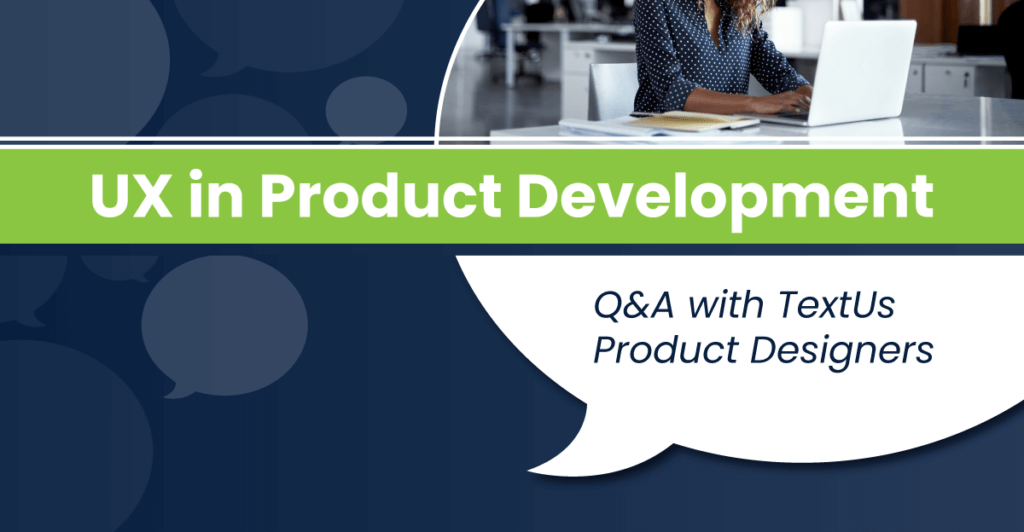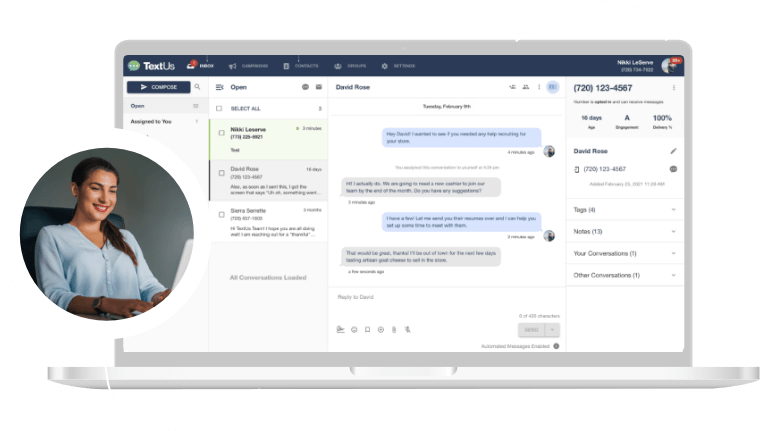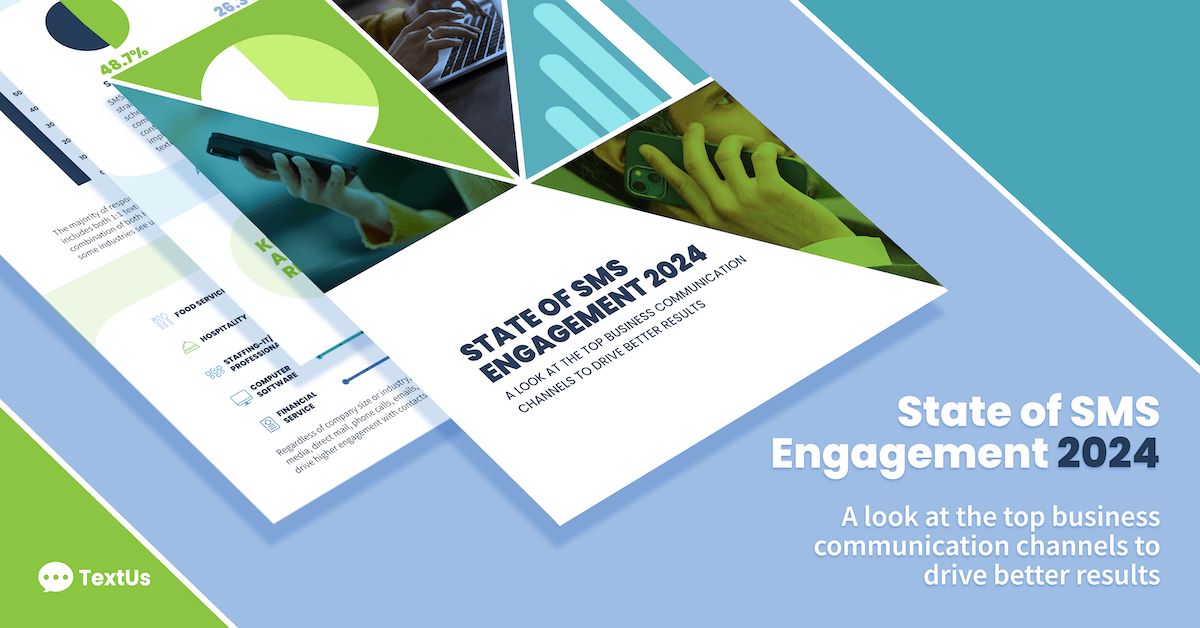UX in Product Development: Q&A with TextUs Product Designers

The importance of user experience in product development has caused companies to recruit for UX roles and place an emphasis on understanding how it impacts products — not only the design but also how features are prioritized. Our UX and product team have grown throughout the past several years, and we sat down with two team members for advice on all things UX.
The role of UX at TextUs
TextUs’ Sr. Product Designer, Stephanie Huang, thinks about how we approach UX and ensures that it is included in the big picture for company strategy. A top priority in that strategy is advocating for the user while also balancing the business goals. Stephanie notes it can be easy to get excited about the user coming first but in reality you have to negotiate in order to be a real differentiator.
Trey Burghardt started as a junior UX designer at TextUs and moved into a mid-level Product Designer role assisting with the UI and UX of products, new features, redesigns, and the team’s transition to Figma. He focuses on the entire UX process from discovery to implementation and understanding what is good for users.
Having worked in sales for G2 previously, Trey sees a benefit to articulate the selling of designs. This account management mindset includes working with stakeholders and leaders to solve their problems as well as working with users and engineers so they can experience and develop the designs for the greatest benefit.
Trey predicts there will be an increased demand for generalist designers — especially at smaller companies like TextUs — those who can do both research and design. While bigger companies can specialize and create specific roles and concentrations, if you need someone to think through the entire UX process — having someone too focused may mean their skills might not be a good fit, or their passion may not be a good fit.
According to Trey, the rise in UX roles means you have to make sure the roles and industry do not become too saturated for the wrong reasons. Stephanie agrees that UX is well valued by the industry right now but you need the right mindset to get into it. This includes being resilient, showing value across the business and not just showing a nice screen. Communicating with everyone at all levels is what makes a great product designer.
“Being able to walk the line between advocating for the user and connecting user needs to business goals is what makes you a great designer.” -Stephanie Huang, Senior Product Designer, TextUs
Why is UX important to product development?
UX can drive product development by adhering to guidelines, regulations, and laws. This makes sure users are not only having positive experiences but they are compliant as well. This can include Web Content Accessibility Guidelines (WCAG) for accessibility features as well as TCPA laws.
UX also prioritizes product planning to make sure development is feasible with engineers. Stephanie says you can make development more efficient by translating UX findings and insights and turning those into actionable, bite-size pieces that can be communicated with leadership, engineers, and other departments. Each audience needs to know specific parts in order to do their job well. By talking to different groups and knowing how to communicate features to each, you can build and sell products in more meaningful ways.
The evolution of UX opens up the process to have better ideation. In some cases you may have engineers who were or are also designers. If you develop and design from the same place, Trey says you may miss out on different viewpoints that look holistically at product uses in order to build the optimal product and think through different elements.
In an ideal world, Stephanie says you would be able to communicate with all stakeholders up-front, learning how each wants the product to act and feel, and then take those expectations and ask users what they want to accomplish. This can lead to a design that helps users achieve their goals while meeting the expectations and constraints of stakeholders, which you then bring back to everyone involved to gather feedback.
Part of the UX process is continually evaluating and measuring that experience to make tweaks as you collect buy-in and keep checking in until a product or feature release. This cycle of iterative feedback allows you to always stay ahead of what users are experiencing and needing to make sure your product is relevant.
Trey looks to the double diamond design approach: discovering and defining the problem in the first part and then developing and delivering the solution. This also takes an iterative approach: you cycle back based on research and feedback to pivot— maybe you have to define, design, and redesign based on what you learn.
Trey believes that the product roadmap changes based on two things: what leadership is seeing, which can include your C-suite as well as board members, and what users are saying, which can include things like G2 reviews and NPS scores. We use Pendo to collect user data at TextUs to help us analyze and inform our product experience and adoption.
“When what your executives are seeing matches up with what your users are saying, you see UX executed wonderfully.” -Trey Burghardt, Mid-level Product Designer, TextUs
UX features
Trey believes UX should make things self-evident to users. They shouldn’t have to think too hard about what they are experiencing or trying to accomplish. Stephanie believes in anticipating a user’s needs when offering personalization in order to give users a quality experience — and one that humanizes the technology.
When you look at the scope of what users need, Stephanie advises that knowing a user’s context is key. For example, are users more likely to act on a specific need using a desktop or a mobile device? This will change the focus for initial designs and how you build the product. Trey says as you look at the different demographics, you should understand what success looks like for each. At TextUs, we have product use cases for audiences as well as building features for the web, mobile app, and Chrome Extension.
Trey wants to give users a seamless experience. You can talk to users and partner with CX to better understand goals. Stephanie evaluates usability heuristics and ensures the product workflow is intuitive and easy for people to understand. Building intuitive interactions is essential for people to understand new technology and adopt a product. You see this in social media development of stories and how multiple platforms adopted it as it gained wide usage.
When it comes to TextUs features, Trey and Stephanie are looking forward to the launch of Sequences. This new feature will allow users to automate text sequences, similar to email. Users will be able to create up to four messages, have the ability to stop the drip if a contact responds, and add admins to campaign conversations.
UX resources and recommendations
Are you looking for more UX resources? Stephanie and Trey recommend these reads for the love of UX!
Book: Don’t Make Me Think



Get a TextUs Demo
Learn how thousands of businesses use TextUs everyday to communicate in real-time.



